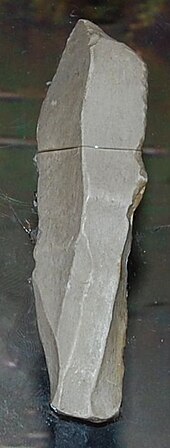 | |
| Geographical range | Great Britain |
|---|---|
| Period | Upper Paleolithic |
| Dates | between 13,000–11,800 BP[1] |
| Type site | Creswell Crags |
| Major sites | Gough's Cave, Kents Cavern |

The Creswellian is a British Upper Palaeolithic culture named after the type site of Creswell Crags in Derbyshire by Dorothy Garrod in 1926.[3] It is also known as the British Late Magdalenian.[4] According to Andreas Maier: "In current research, the Creswellian and Hamburgian are considered to be independent but closely related entities which are rooted in the Magdalenian."[5] The Creswellian is dated between 13,000 and 11,800 BP[1] and was followed by the most recent ice age, the Younger Dryas, when Britain was at times unoccupied by humans.[6]
- ^ a b Robert Hosfield, Vanessa Straker and Paula Gardiner with contributions from Anthony Brown, Paul Davies, Ralph Fyfe, Julie Jones and Heather Tinsley (2007). "Palaeolithic and Mesolithic". In Webster, C.J. (ed.). The Archaeology of South West England. Somerset County Council. p. 36.
There are numerous radiocarbon determinations on human remains, butchered animal bones and organic artefacts which date the Creswellian to between 13,000-11.800 BP (Jacobi 2004).
{{cite book}}: CS1 maint: multiple names: authors list (link) - ^ The museum's exhibit label says "Cresswell points were probably hafted knife blades", Derby Museum, read July 2011
- ^ Davies, William; et al. (1999). Dorothy Garrod and the progress of the Palaeolithic: studies in the prehistoric archaeology of the Near East and Europe. Oxbow Books. p. 282.
- ^ Pettit, Paul; White, Mark (2012). The British Palaeolithic: Human Societies at the Edge of the Pleistocene World. Abingdon, UK: Routledge. p. 440. ISBN 978-0-415-67455-3.
- ^ Maier, Andreas (2015). The Central European Magdalenian: Regional Diversity and Internal Variability. Springer. p. 133.
- ^ Stringer, Chris (2011). "The Changing Landscapes of the Earliest Human Occupation of Britain and Europe". In Ashton, N.; et al. (eds.). The Ancient Human Occupation of Britain. Elsevier. p. 1. ISBN 9780444535979.